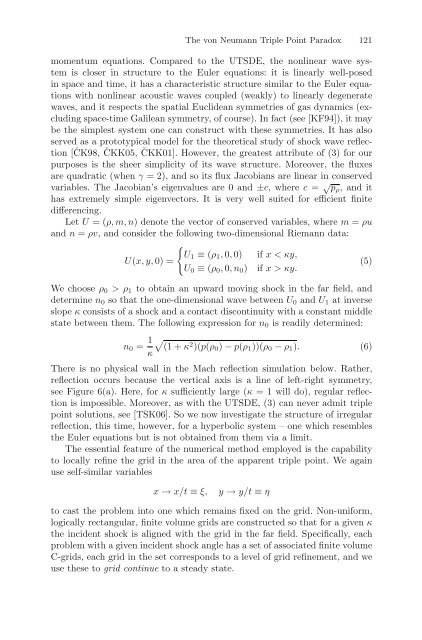Partial Differential Equations - Modelling and ... - ResearchGate
Partial Differential Equations - Modelling and ... - ResearchGate
Partial Differential Equations - Modelling and ... - ResearchGate
Create successful ePaper yourself
Turn your PDF publications into a flip-book with our unique Google optimized e-Paper software.
The von Neumann Triple Point Paradox 121<br />
momentum equations. Compared to the UTSDE, the nonlinear wave system<br />
is closer in structure to the Euler equations: it is linearly well-posed<br />
in space <strong>and</strong> time, it has a characteristic structure similar to the Euler equations<br />
with nonlinear acoustic waves coupled (weakly) to linearly degenerate<br />
waves, <strong>and</strong> it respects the spatial Euclidean symmetries of gas dynamics (excluding<br />
space-time Galilean symmetry, of course). In fact (see [KF94]), it may<br />
be the simplest system one can construct with these symmetries. It has also<br />
served as a prototypical model for the theoretical study of shock wave reflection<br />
[ČK98, ČKK05, ČKK01]. However, the greatest attribute of (3) for our<br />
purposes is the sheer simplicity of its wave structure. Moreover, the fluxes<br />
are quadratic (when γ = 2), <strong>and</strong> so its flux Jacobians are linear in conserved<br />
variables. The Jacobian’s eigenvalues are 0 <strong>and</strong> ±c, wherec = √ p ρ ,<strong>and</strong>it<br />
has extremely simple eigenvectors. It is very well suited for efficient finite<br />
differencing.<br />
Let U =(ρ, m, n) denote the vector of conserved variables, where m = ρu<br />
<strong>and</strong> n = ρv, <strong>and</strong> consider the following two-dimensional Riemann data:<br />
{<br />
U 1 ≡ (ρ 1 , 0, 0) if x < κy,<br />
U(x, y, 0) =<br />
(5)<br />
U 0 ≡ (ρ 0 , 0,n 0 ) if x > κy.<br />
We choose ρ 0 >ρ 1 to obtain an upward moving shock in the far field, <strong>and</strong><br />
determine n 0 so that the one-dimensional wave between U 0 <strong>and</strong> U 1 at inverse<br />
slope κ consists of a shock <strong>and</strong> a contact discontinuity with a constant middle<br />
state between them. The following expression for n 0 is readily determined:<br />
n 0 = 1 κ√<br />
(1 + κ2 )(p(ρ 0 ) − p(ρ 1 ))(ρ 0 − ρ 1 ). (6)<br />
There is no physical wall in the Mach reflection simulation below. Rather,<br />
reflection occurs because the vertical axis is a line of left-right symmetry,<br />
see Figure 6(a). Here, for κ sufficiently large (κ = 1 will do), regular reflection<br />
is impossible. Moreover, as with the UTSDE, (3) can never admit triple<br />
point solutions, see [TSK06]. So we now investigate the structure of irregular<br />
reflection, this time, however, for a hyperbolic system – one which resembles<br />
the Euler equations but is not obtained from them via a limit.<br />
The essential feature of the numerical method employed is the capability<br />
to locally refine the grid in the area of the apparent triple point. We again<br />
use self-similar variables<br />
x → x/t ≡ ξ,<br />
y → y/t ≡ η<br />
to cast the problem into one which remains fixed on the grid. Non-uniform,<br />
logically rectangular, finite volume grids are constructed so that for a given κ<br />
the incident shock is aligned with the grid in the far field. Specifically, each<br />
problem with a given incident shock angle has a set of associated finite volume<br />
C-grids, each grid in the set corresponds to a level of grid refinement, <strong>and</strong> we<br />
use these to grid continue to a steady state.
















